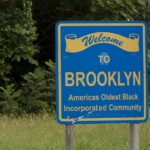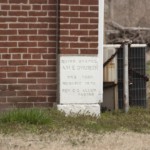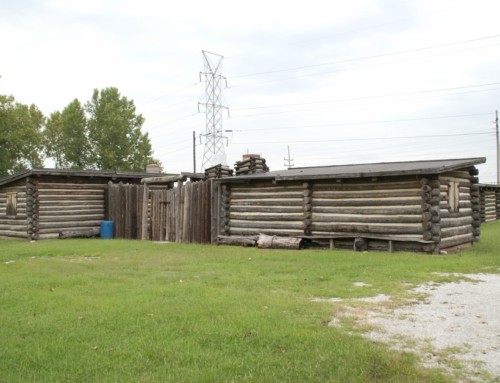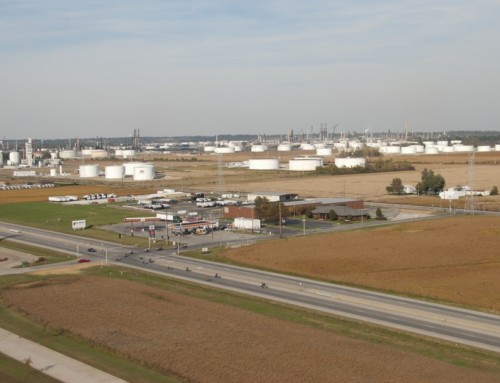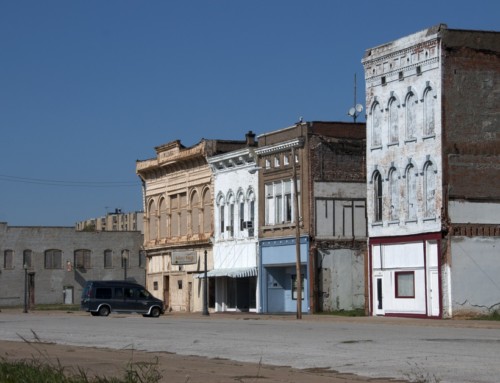Introduction
Driving through Brooklyn, there’s barely a hint of the town’s long history as a refuge and enclave for African American freedom. The oldest incorporated black-majority town in the US, Brooklyn has seen good times and bad, but today’s residents are hoping that honoring their past will pave the way to a better future.
History
Brooklyn was founded around 1830 when “Mother” Priscilla and John Baltimore led a group of eleven African American families—some free and some who had escaped enslavement—across the Mississippi River from St. Louis to found a sanctuary they called Freedom Village. When the village was established, the east bank of the Mississippi River at St. Louis was a collection of farms mixed in with floodplain forests; there were few settlements.
Mother Priscilla was active in the Methodist Church and worked with the Reverend William Paul Quinn in the 1830s to establish the first African Methodist Episcopal (AME) Church in the Midwest. According to oral histories, Reverend Quinn preached about freedom in some creative ways; in winter, for example, he walked out onto the frozen Mississippi River to the middle of the river and preached loud enough for enslaved workers to hear him. He also had a part in founding St. Paul’s AME Church in St. Louis, which is the oldest black church in St. Louis. Quinn Chapel AME Church in Brooklyn was part of a chain of AME churches the helped move enslaved people to freedom along the Underground Railroad. Antioch Baptist Church in Brooklyn also played an active role with the Underground Railroad.
In 1837, five white abolitionists platted a town at Freedom Village and named it Brooklyn; the village grew into a biracial community with a black majority population. Brooklyn provided a refuge for formerly enslaved people but also attracted white laborers. The village was had the misfortune of being platted during an economic depression, so it didn’t get out of the gate very quickly. When the railroads chose Illinoistown (now East. St. Louis) as their terminal instead of Brooklyn, the town’s fortunes took a hit again.
In 1850, the town, still unincorporated, counted 300 residents (60% of whom were Black), who farmed, ran stores, worked as unskilled laborers, as well as in skilled professions as artisans and craftspeople. Brooklyn incorporated in 1873, but the post office began referring to it as Lovejoy in 1891 because there was already a town in Illinois called Brooklyn, in Schulyer County. The name came from the first school in the city, which was called Lovejoy in honor of the abolitionist leader, Elijah P. Lovejoy, who had been killed in Alton, Illinois, by a pro-slavery mob in 1837. The Lovejoy school was part of a successful effort by African Americans in Brooklyn to integrate schools.
For the first thirteen years after incorporation, white residents had a 4-3 majority on the Board of Trustees, even though they were a minority of the town’s residents. In 1886, John Evans led a successful campaign for the black majority to win control of the Board; he became the city’s first black mayor in the process. Evans had migrated to Brooklyn from Virginia in 1870. He farmed for a while, but by 1891 he had started working as a laborer for the Wabash Railroad Car Repair Shop. He emerged as one of the town’s primary leaders in late 1800s and led the effort to for the African American majority to gain control of the city’s government. He served as mayor from 1886 to 1894, during which time he got electric lights installed in the city, paved roads, built city hall, and purchased land for a cemetery. He also successfully beat back a movement in July 1891 to annex Brooklyn to East St. Louis, an effort that was spearheaded by white residents and a few political opponents of Evans.
Brooklyn’s residents celebrated Emancipation Day annually for many decades. It was marked with speeches from community leaders, a parade with a marching band, and by singing freedom songs. The village also officially celebrated Lovejoy’s birthday (March 31) as a holiday.
Brooklyn was submerged by a major flood in 1892, which crested in mid-May. Residents fled to a nearby island for safety. In 1894, white residents petitioned the black-majority government for a separate school for white children; the board eventually approved their request.
Migration from the South pushed the village’s population to 1,577 in 1910 (88% of whom were African American); many of the new residents were single men. The population boom created a housing shortage, which resulted in crowded boarding homes that were often in poor condition, but some local families also earned extra money by taking in boarders.
Still, city leaders never had much luck attracting development, even as new factories sprung up all around them. Between 1875 and 1919—the era of rapid industrial growth in St. Louis and in the US—47 new factories opened across the river from St. Louis, but not one of them located in Brooklyn. Instead, Brooklyn remained primarily a residential community for the black employees of neighboring factories. Many black men worked in the Granite City steel plants, but they couldn’t live there because of the city’s sunset laws; instead, they lived in Brooklyn and commuted to Granite City by streetcar. Many other Brooklyn residents worked in the adjacent National City stockyards or at another factory in the region. Most African American women worked in service jobs, typically as a laundress, domestic servant, or waitress.
Brooklyn also had trouble developing its own retail base because it was so close to East St. Louis. Starved for revenue to provide basic city services, Brooklyn developed into a place where folks went to drink, gamble, and have sex. Liquor licenses provided revenues for the city, and many of the city’s political leaders were bar owners.
The city has had its share of political turmoil. Mayor Frederick Vanderberg was convicted of embezzlement in 1903. A decade later, rival political factions each claimed power after a disputed election. They appointed their own police chiefs and eventually fought it out to resolve the issue; several people were killed in the process. St. Clair County sheriff, Logan Mellon, intervened on May 8, 1915, by essentially declaring martial law. He assigned four officers to patrol the town, collect guns, and close bars. Things quieted down after that.
Like many older towns in the region, Brooklyn’s population peaked in the middle of the 20th century; Brooklyn counted 2,568 residents in 1950, but the population has dramatically declined since, bottoming out in 2000 at 676 people. Since then, the population has rebounded a bit.
Brooklyn today is a struggling community where half of the residents live below the poverty line and where the major (only) industry is adult entertainment. In spite of their challenges, residents have taken up efforts to recognize and publicize the town’s unique heritage in the hopes that the community that many still call Lovejoy can turn its fortunes around.
**Brooklyn is covered in Road Tripping Along the Great River Road, Vol. 1. Click the link above for more. Disclosure: This website may be compensated for linking to other sites or for sales of products we link to.
Resources
- Post Office: 413 S. 3rd St.
Where to Go Next
Heading upriver? Check out Venice.
Heading downriver? Check out Cahokia Mounds State Historic Site.
Community-supported writing
If you like the content at the Mississippi Valley Traveler, please consider showing your support by making a one-time contribution or by subscribing through Patreon. Book sales don’t fully cover my costs, and I don’t have deep corporate pockets bankrolling my work. I’m a freelance writer bringing you stories about life along the Mississippi River. I need your help to keep this going. Every dollar you contribute makes it possible for me to continue sharing stories about America’s Greatest River!
©Dean Klinkenberg, 2024, 2021, 2018,2013,2011
